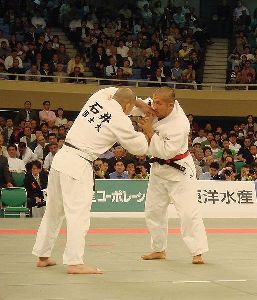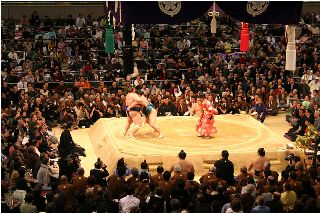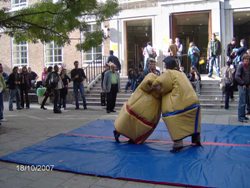Sports
Image by: © Olivia Braddock
Judo(柔道)
Judo, which means “the way of gentleness”, was started by Dr Jigoro Kano in 1885. Dr Kano had been studying Jujutsu and was looking to establish a martial art that gave flexibility in the application of technique. There is a ranking system according to ability (Dan), and this is indicated by the colour of the belt that is worn.
Photo by: Agima Under Creative Commons Licence
Karate (空手)
Karate has its origins in the Ryuku Islands, now part of Okinawa, in South West Japan. It can be practised both as a sport and as a self-defence technique, and involves the use of hands, arms, legs and feet. Karate has evolved into a number of different styles, according to the beliefs of different leaders. Ability is graded by Dan, denoted by different coloured belts.
Kendo (剣道)
Kendo means “the way of the sword”. It is based on traditional Japanese sword-fighting techniques. It is a popular sport in schools. Ability is graded in Dan, of which there are eight levels. The shinai, or sword, is held with two hands. It was originally made from four pieces of bamboo held together with a leather strap, but is now made from carbon fibre.
Photo by: Agima Under Creative Commons Licence
Sumo (相撲)
Sumo wrestling is probably the most unique of sports as to participate requires following a particular way of life. It is full of tradition and, although there are a number of non-Japanese who participate, it is really only known outside of Japan through demonstration tournaments. Typically, Sumo are of a particular physique by following a rigid diet, and posses long hair tied in a knot over their head. They often live in Sumo stables, or ‘heya’, and follow a strict way of life.
Photo by: BradBeatle Under Creative Commons Licence
The start of a bout is very ritualistic. The preparation time gets longer as the Sumo moves up the rankings. To win a bout the wrestler must force his opponent to step out of the ring. The bouts are very short, sometimes only a matter of seconds.
Sumo in SOAS!
Photo by: © Terry King
Students at SOAS (the School of Oriental and African Studies), London, play at Sumo wrestling in Sumo suits!
Baseball (野球(やきゅう))
Baseball was introduced into Japan in 1872 and has been a very popular game ever since.
The professional teams belong to Nippon Professional Baseball and are divided into two leagues of six teams each, Central and Pacific Leagues. Teams are owned by large corporations and their names reflect this rather than their location. A number of Japanese players now play for teams in the USA. See http://www.npb.or.jp/ High Schools also participate in competitions in the spring and summer, the final stage games of which are broadcast live on national television. These have almost as much following as the professional league games.Soccer (サッカー)
Soccer has been played in Japan since the 1870s. However, it is only as recently as 1993 that the professional soccer started with the establishment of the J-League. Since 1999 there have been two divisions (J1 – 18 clubs & J2 – 19 clubs)). Japanese players have started to play with clubs around the world. Check out the J-League web site; http://www.j-league.or.jp/eng/ Have a look to find out which team is currently top of the league? In 2002 Japan, jointly with Korea, hosted the World Cup. It has qualified for 1998, 2002, 2006 and 2010 competitions. The national team strip is Samurai blue.



